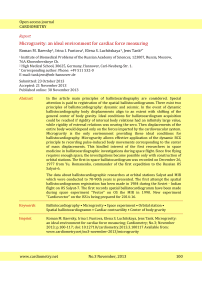Microgravity: an ideal environment for cardiac force measuring
Автор: Baevsky Roman М., Funtova Irina I., Luchitskaya Еlena S., Таnk J.
Журнал: Cardiometry @cardiometry
Рубрика: Report
Статья в выпуске: 3, 2013 года.
Бесплатный доступ
In the article main principles of ballistocardiography are considered. Special attention is paid to registration of the spatial ballistocardiogramm. There exist two principles of ballistocardiography: dynamic and seismic. In the event of dynamic ballistocardiography body displacements align to an extent with shifting of the general center of body gravity. Ideal conditions for ballistocardiogram acquisition could be reached if rigidity of internal body relations had an infinitely large value, while rigidity of external relations was nearing the zero. Then displacements of the entire body would depend only on the forces imparted by the cardiovascular system. Microgravity is the only environment providing these ideal conditions for ballistocardiography. Microgravity allows effective application of the dynamic BCG principle to recording pulse-induced body movements corresponding to the center of mass displacements. This kindled interest of the first researchers in space medicine in ballistocardiographic investigations during space flight...
Ballistocardiography, cardiac contractility, center of body gravity, microgravity, orbital station, space experiment, spatial ballistocardiogramm
Короткий адрес: https://sciup.org/148308747
ID: 148308747
Список литературы Microgravity: an ideal environment for cardiac force measuring
- Dock W, Mandelbaum R, Mandelbaum H. Ballistocardiography. New-York1954. 246 p.
- Dock W. The tree-plane ballistocardiogram in heart failure. Am. Journ. Cardiol. 1959;3(3):384-6.
- Nickerson J, Curtis H. The design of the ballistocardiography. Am. J. Physiol. 1944;142:1-11.
- Noordergraaf A. Physical aspects of the "direct" recording of body displacement, velocity, and acceleration by shinbar ballistocardiographs. Circulation. 1961;23:426-33 DOI: 10.1161/01.CIR.23.3.426
- Parin VV. Ballistocardioaphy and it significance in clinic. Clinical medicine. 1966;34(6):12-34.
- Scarborough WR, Talbot SA. Proposals for ballistocardiographic nomenclature and conventions. Revised and extended report of Committee on ballistocardiographic terminology. Circulation. 1956;14:435-50.
- Baevsky RM, Talkov AA. Ballistocardiography. Sofia1970. 265 p.
- Baevsky R, Funtova II. Ballistocardiographic of research during 4th expedition at orbital station "Salyut-6". Space Biology and Aerospace Medicine. 1982;16:34-7.
- Baevsky R, Chatardzhi PS, Funtova II. Declines of contractile function of heart in the conditions of weightlessness by results of 3-plane ballistocardiography. Space Biology and Aerospace Medicine. 1987;21:26-31.
- Baevsky R, Poljakov VV, Moser. Adaptation of blood circulation to conditions of long weightlessness: ballistocardiographic researches during 14-month's space flight. Aviaspace & Ecology Medicine (Russian Journal). 1998;32:23-30.
- Baevsky R, Funtova II, Tank J. The use of seismo-and ballistocardiography in Russian aviation and space medicine. A short historical review. Clinical Informatics and Telemedicine. 2012;9:99-111.
- Scano A, Rispoli E, Strollo F, Cama G, Guidetti L, Brazzoduro G. Three dimensional ballistocardiography in weightlessness (experiment 1ES-028). Life Sciences Research in Space. 1984.
- Starr I. Essay on the ballistocardiogram. J. Am. Med. Ass. 1954;155:1413-25.
- Starr I, Noordergraaf A. Ballistocardiography in cardiovascular research. Amsterdam1967.


